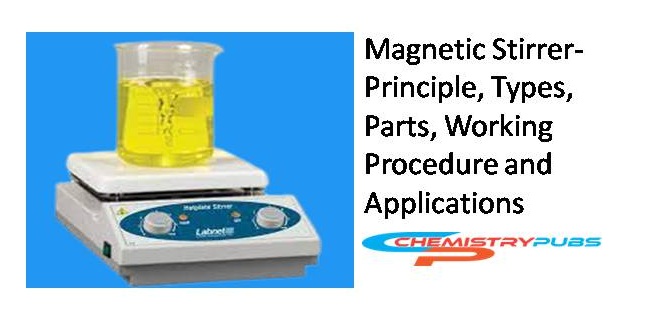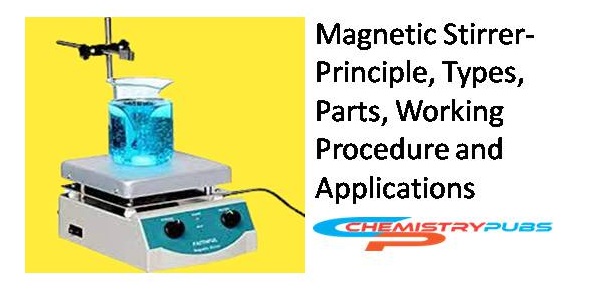A magnetic stirrer or stir plate is a kind of laboratory device that associated a rotating magnetic field generated by a stationary electromagnet to cause a stirrer bar immersed within a liquid to spin and thus quickly stir the solution. This stirrer was invented in 1917 by Richard Stringham.
An attached heating system for warming the liquid is typically an important part of a magnetic stirring system. It can be stirred easily which has lower viscosity. It should be used Glass or other non-metallic beakers to avoid interference with the magnetic field. It is a very useful device for stirring in academic work, business, agriculture, health care, etc.
Principle of Magnetic Stirrer
The principle of magnetic stirrer depends on the attraction for opposite charges and repulsion for like charges. The stirring speed of this instrument can be adjusted and is used to stir solvents of various viscosities. A small electric motor powers a magnet to create a rotating magnetic field that rotates the stirring bar inside the vessel, and enables a thoroughly mixed reaction to take place.

This device comprises a temperature control system that can heat and regulate the tested sample’s temperature in accordance with experiment requirements and ensures that the mixed liquid satisfies the experiment’s requirements while keeping the required temperature.
Types of Magnetic Stirrers
There exist many types of magnetic stirrers depending on their size, configuration, and applications. There gives some of the types of magnetic stirrers are as follows:
Magnetic Mini Stirrer
This type of magnetic stirrer has the ability to withstand destructive and corrosive substances in the lab. The regulator speed of this instrument manages the rotation per minute (rpm). It requires less space in the laboratory for using its various purposes.
Magnetic Stirrer with Timer
The motor of this stirrer can be turned off after a certain time for using it for various purposes. The speed of this stirrer is automatically decreased, and the weight is automatically removed.
Heavy-Duty Magnetic Stirrer
This stirrer has the highest capacity for precise findings. The most of chemical reactions in the laboratory can be done by this stirrer.
Battery Powered Magnetic Stirrer
This type of stirrer is portable and lightweight to carry. It can be used in places with no electricity or other restricted environments. This magnetic stirrer is mostly used in incubators, operates on batteries, and has rubber feet to provide stability.
Air-operated Turbine Magnetic Stirrer
This type of stirrer is used for blending liquids up to 1 liter of solution. This magnetic stirrer can be driven by supplying low-pressure air. There is no risk of sparking from electrical sources in this stirrer.
The air-operated turbine magnetic stirrer is the ideal tool for blending liquids up to 1 liter of solution.
Instrumentation of a Magnetic stirrer with a hot plate
A hot plate and a stir bar are the two important parts of a magnetic stirrer. A temperature control knob, a speed control knob, and a stationary electromagnet are some of the additional components found inside a hot plate stirrer machine.
Top plate/Hot plate: It is made of ceramic or stainless steel which makes the stirrer for titration purposes. They have higher chemical resistivity making them ideal while working with corrosive chemicals that may splash onto the plate surface.
Stir bar: This part is known as spin bar” which is a white, Teflon-coated, and rectangular magnet. This bar is kept in a liquid-filled container and then placed over a stirring motor. Then the bar spins and the liquid is stirred when the stir motor is started to move. The dimensions of this bar range from millimeters to a few centimeters.
Stationary electromagnet: This electromagnet remains inside the instrument and helps to create a magnetic field and rotate the magnetic needle immersed in liquid.
Speed controlling knob: This part is used for adjusting the rotational speed (rpm) of the stir bar depending on the liquid’s density or project needs.
Temperature controlling knob: This part controls the temperature based on the vessel size, the viscosity of the liquid, and its volume.
Stir bar retriever:
These magnets are connected with a PTFE rod. It helps to create the safe and easy recovery of magnetic stirring and spin bars from irritant and corrosive liquid samples in glass flasks.
Magnetic Stirrer operating procedure
Firstly, take the liquid solution in a container and place it on the hotplate. Then connect to the mains to turn on this apparatus. Adjust the hotplate’s temperature by pressing the temperature setting button. Then a magnetic stir bar should be placed in a vessel filled with solution. Then turn the stirrer magnetic speed adjustment button clockwise for changing the speed of the magnetic stirrer.
You can reduce the speed by adjusting the knob’s counter-clockwise direction. Stir the tested mixture until uniformity is achieved. You can remove the container after completing the rotation. Finally, it should be disconnected from the mains to turn off the hotplate.
Applications of Magnetic Stirrer
It is very much used in laboratories for performing various chemical experiments and syntheses by mixing two or more components. It is used for preparing a medium to culture microorganisms in microbiology laboratories. It is used for preparing various samples and performing analysis in chemistry and biology experiments. It is used for extracting various organic components from plant materials. It is a very important apparatus for oil analysis, soil suspending, buffer solutions preparation, pH measurement, etc.
Advantages of Magnetic Stirrer
It helps to mix reagents at a constant temperature. This sealed container prevents intense boiling from occurring. It can possibly protein dialysis by helping this apparatus. It needs a small place to operate because it has a good compact size.
Limitations of the stir plate
It does not remove various harmful nanoparticles. It is difficult to deal with magnetic stirrers for viscous liquids or thick suspensions.
Precautions of the stir plate
It should be grounded to prevent mishaps. It should be kept clean, forbid the solution from entering it, and turn off the power when not in use.
References
1.Engel, P. S. (1978). Magnetic stirrer with no external moving parts.

